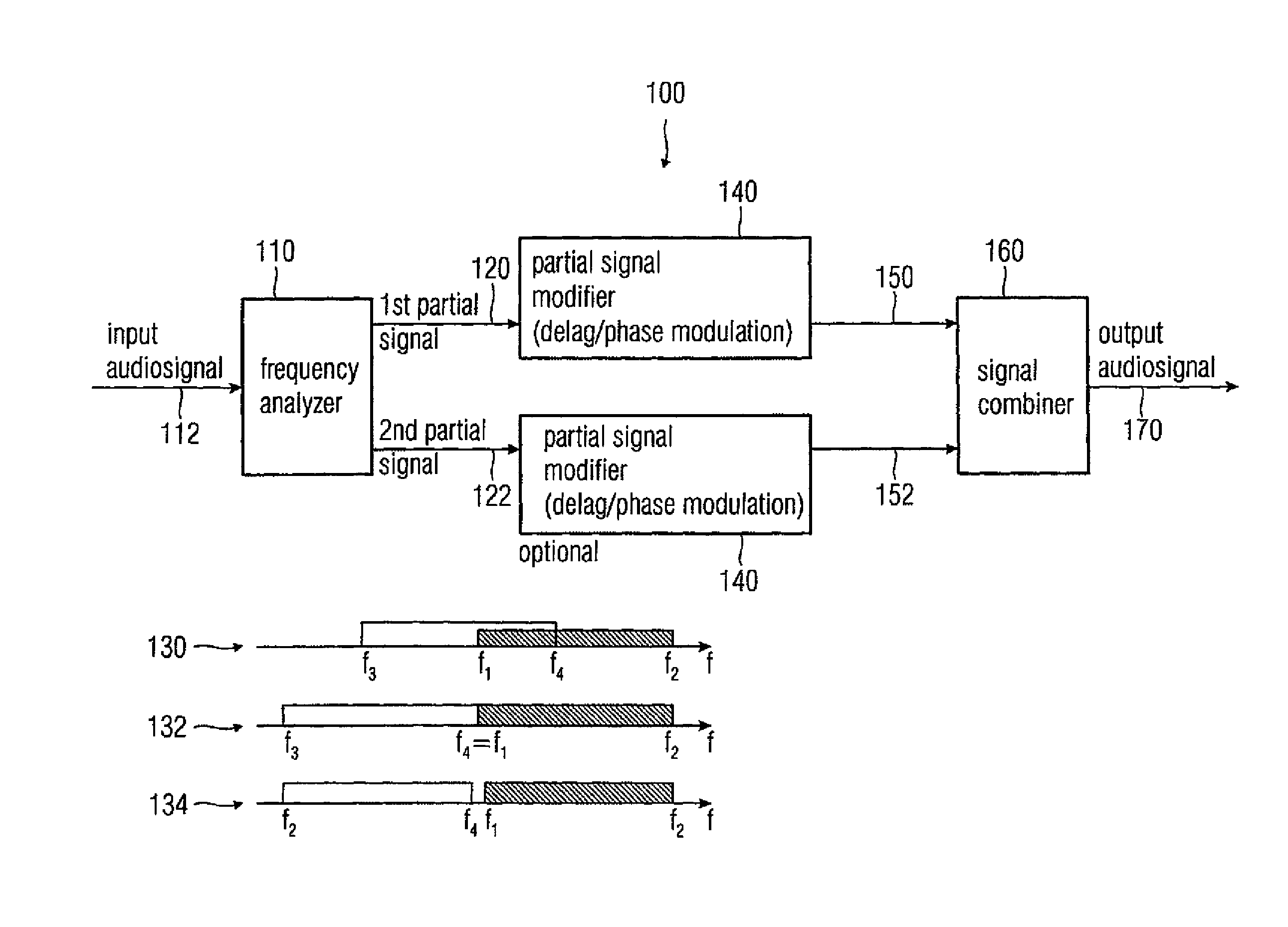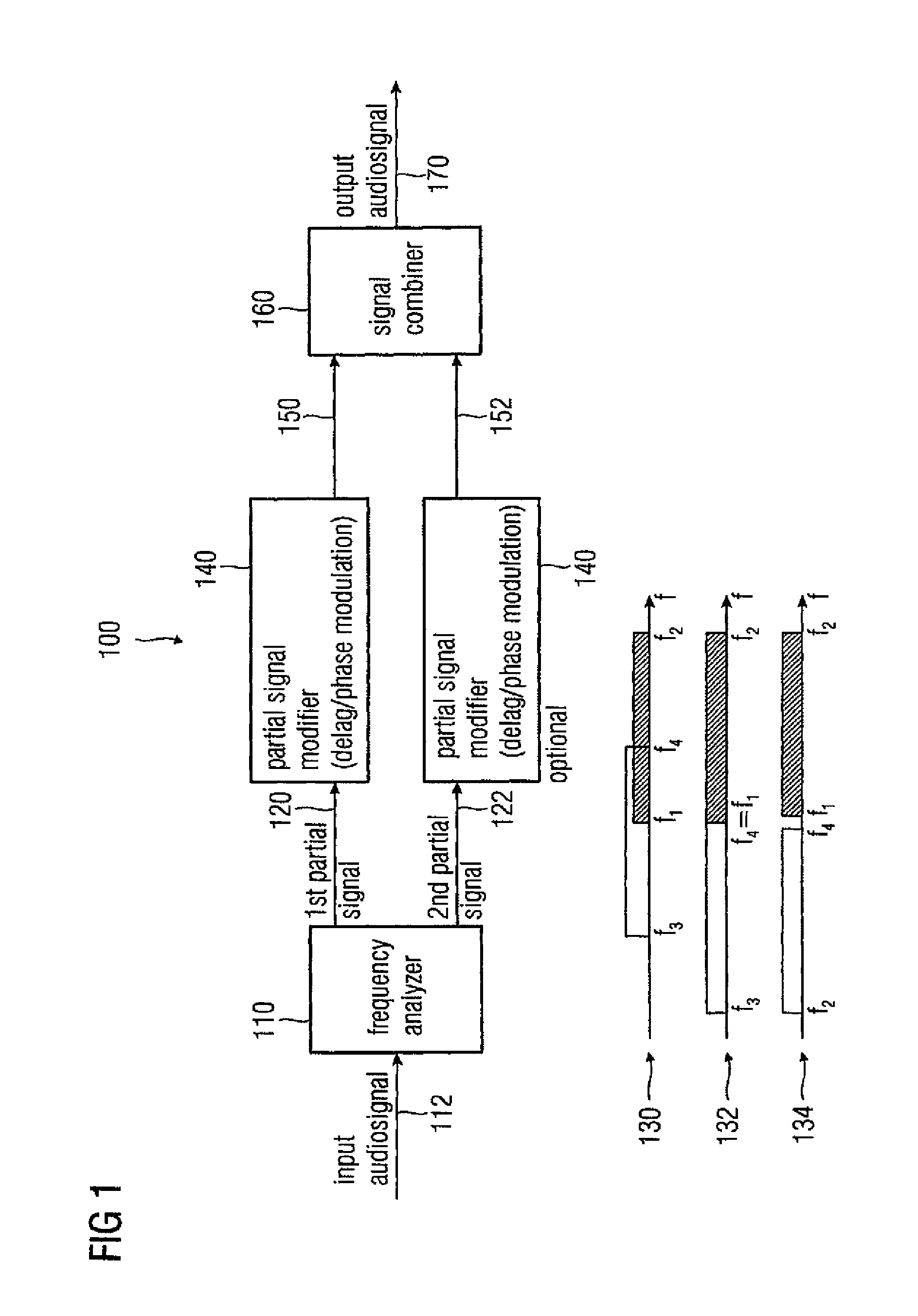Audio signal decorrelator, multi channel audio signal processor, audio signal processor, method for deriving an output audio signal from an input audio signal and computer program
a multi-channel audio signal and decorrelator technology, applied in speech analysis, two-way loud-speaking telephone systems, transmission, etc., can solve the problems of affecting the echo cancellation performance, affecting the quality of the input audio signal, and possesses extremely low complexity
- Summary
- Abstract
- Description
- Claims
- Application Information
AI Technical Summary
Benefits of technology
Problems solved by technology
Method used
Image
Examples
first embodiment
[0081]FIG. 1 shows a block schematic diagram of an inventive audio signal decorrelator according to the present invention. The audio signal decorrelator of FIG. 1 is designated in its entirety with 100. The audio signal decorrelator 100 comprises a frequency analyzer 110, which receives an input audio signal 112. The frequency analyzer 110 analyzes the input audio signal 112 and produces a first partial signal 120 and a second partial signal 122. The first partial signal 120 is descriptive of an audio content in a first audio frequency range, and the second partial signal 122 is descriptive of an audio content in a second audio frequency range.
[0082]The first audio frequency range comprises higher frequencies compared to the second audio frequency range. For example, the first audio frequency range and the second audio frequency range may be contiguous frequency ranges within the audio frequency range of about 10 Hz to 30 kHz.
[0083]For example, the first audio frequency range may co...
second embodiment
[0092]FIG. 2 shows a block schematic diagram of a multi channel audio signal processor according to the present invention. The multi channel audio signal processor of FIG. 2 is designated in the entirety with 200. The audio signal processor 200 receives a multi channel audio signal, for example a two channel audio signal. For example, the multi channel audio signal processor 200 receives a first channel audio signal 210 and a second channel audio signal 212. The multi channel audio signal processor 200 further comprises a first audio signal decorrelator 220. The first audio signal decorrelator 220 is for example identical to the audio signal decorrelator 100 described with reference to FIG. 1.
[0093]The first audio signal decorrelator 220 provides at its output a first decorrelated output audio signal 230. The multi channel audio signal processor 200 further provides at an output a second decorrelated output audio signal 232, wherein the second decorrelated output audio signal 232 is...
third embodiment
[0098]FIG. 3 shows a block schematic diagram of an inventive audio signal decorrelator, according to the present invention. The audio signal decorrelator of FIG. 3 is designated in a entirety with 300. Audio signal decorrelator 300 receives an input audio signal 310. An analysis filterbank 312 receives the input audio signal 310 and provides at least two (advantageously: more than two) partial signals 314, 316, 318. The partial signals 314, 316, 318 describe audio contents of the input audio signal 310 in different audio frequency ranges, wherein the audio frequency ranges may be overlapping, adjacent or separate, as described with reference to FIG. 1. The analysis filterbank 312 splits up the audio signal 310 in a plurality of partial signals covering different (but possibly overlapping) audio frequency ranges. The partial signals 314, 316, 318 may for example comprise bandpass time signals extracted from different audio frequency ranges of the input audio signal 310. Alternatively...
PUM
 Login to View More
Login to View More Abstract
Description
Claims
Application Information
 Login to View More
Login to View More - R&D
- Intellectual Property
- Life Sciences
- Materials
- Tech Scout
- Unparalleled Data Quality
- Higher Quality Content
- 60% Fewer Hallucinations
Browse by: Latest US Patents, China's latest patents, Technical Efficacy Thesaurus, Application Domain, Technology Topic, Popular Technical Reports.
© 2025 PatSnap. All rights reserved.Legal|Privacy policy|Modern Slavery Act Transparency Statement|Sitemap|About US| Contact US: help@patsnap.com



